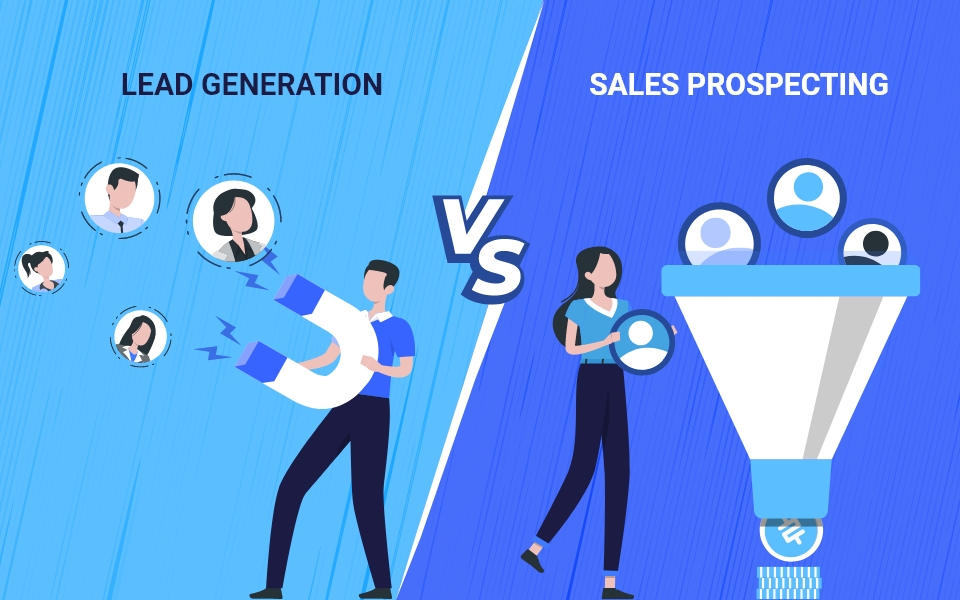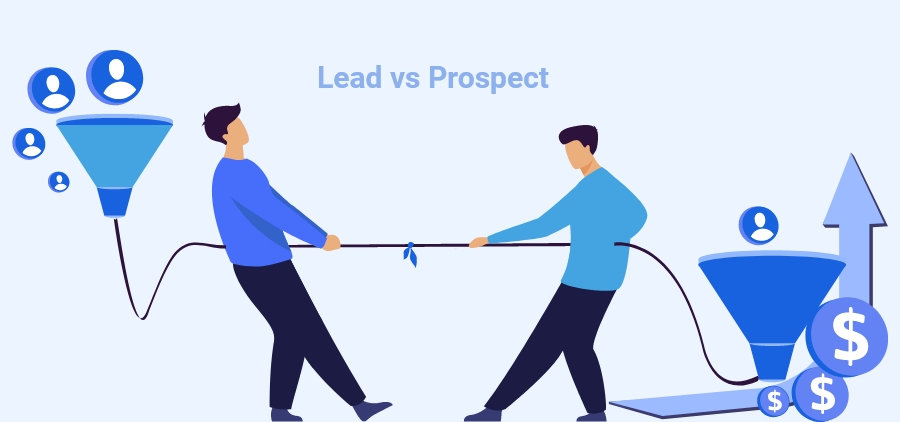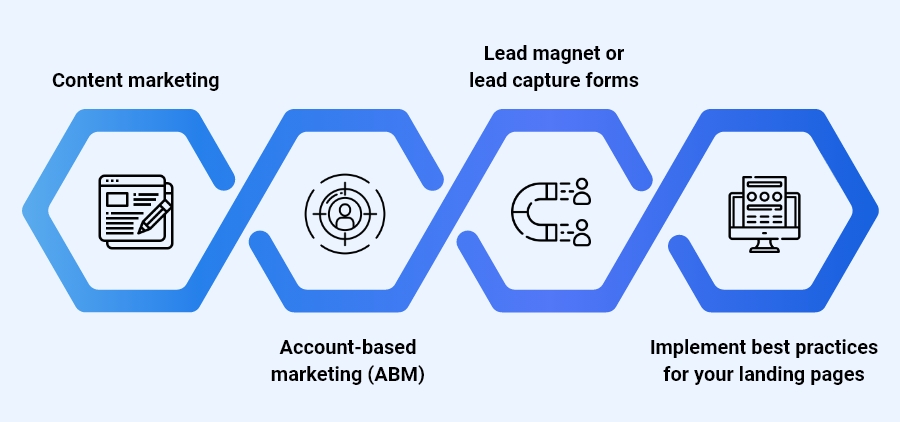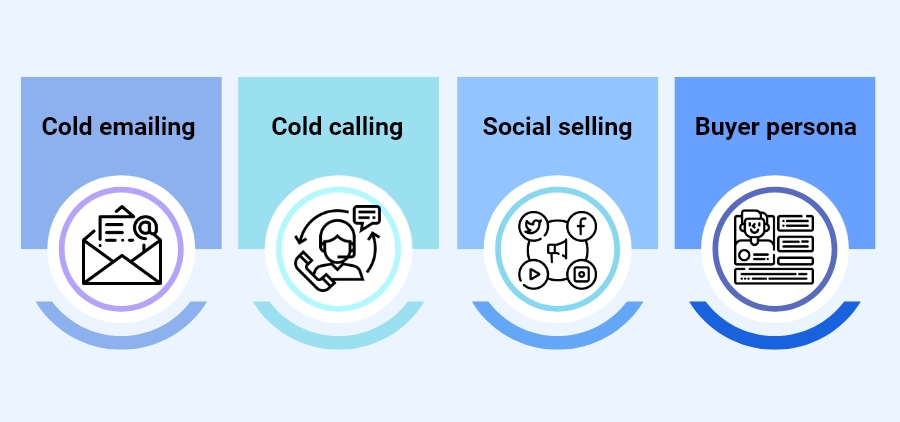Subscribe to Newsletter
Stay up-to-date with the latest tips & strategies. Get additional discounts & alerts on offers.

Lead generation vs sales prospecting is a never ending debate in the marketing and sales world. They are both considered to be similar to each other, but the truth is that they are poles apart since the aims and methods used for them differ from each other. Both lead generation and sales prospecting are often used interchangeably as they both help you bring qualified leads into the pipeline.
According to Lead Genera, businesses often struggle to make sales and see growth without lead generation. Choosing the better one for your B2B business will depend on your product, customer base, stage of growth, and more. Understanding the difference between both methods will help you achieve more success in your sales efforts.
Leads are people or business entities that have shown interest in your company’s products or services by taking actions such as visiting a website, downloading a report, or installing a free version of an app but haven’t become your client yet. Leads also show interest by providing contact details in exchange for gated content with lead forms that give them access to the said content
An example of this is, subscribing to your newsletter. You can reach out to them with sales pitches through the contact information you receive from them.

Prospects are people that the sales representatives qualify as highly relevant potential customers. The person does not need to provide you with their contact information or show interest in your products and services to become a prospect. Once they have predetermined characteristics, they become qualified prospects.
Prospects are usually shortlisted from a list of leads prepared by the marketing department and are nurtured to go down the sales funnel.
The simple answer to this is no! The term lead prospecting directly results from marketing and salespeople confusing prospecting and lead generation. For the difference between leads and prospects, not all leads are equal for your company, since they may not be qualified and a good fit for your business.

While prospects have a higher chance of converting into a customer, you may have some sort of correspondence with leads, but not all leads are the right match for your business. Prospects are people who meet all the given requirements to qualify as perfect customers. We have also written another blog that gives you a detailed comparison between lead VS prospects.
Let’s understand what prospecting and lead generation are in-depth!
Most marketers already know lead generation’s definition, but let us simplify it for you! Lead generation services are all about converting potential customers into leads and capturing their contact information. This is done by creating lead generation campaigns with lead magnets for driving traffic toward the landing pages.
The main goal of implementing lead generation strategies is to convince leads to give their contact information in exchange for something of value. The first step of lead generation is planning out the lead generation process, implementing strategies, and building the sales pipeline
Examples of B2B lead generation include e-books, whitepapers, webinars, cold calls, email marketing, etc
Sales prospecting is a process in which you convert prospects into customers by nurturing them to go down the sales funnel. The main examples of sales prospecting are cold calls, cold emails, and social media outreach. An inbound marketing study done by Hubspot revealed that over 37% of sales representatives perceive prospecting as the most challenging part of the sales process.
Unlike the lead generation that can be automated, sales prospecting requires manual effort and cold outreach to bring in potential customers. The goal of sales prospecting is to identify by going through the process of nurturing and educating them about the company’s products and services.
Now let’s compare lead generation VS sales prospecting strategies!

Content marketing is one of the most effective lead generation strategies as it engages with your lead through blogs, webinars, eBooks, or whitepapers. If you are planning to make gated content make sure that you provide high-quality content that will be of value to your target audience.
The content is usually curated based on their pain points. In lead generation vs sales prospecting, lead generation gets an upper hand because providing tailored marketing & sales increases growth opportunities and help you in higher expansion.
A lead magnet is a free asset that companies use to incentivize their audience in exchange for contact information on the landing pages. The first and foremost rule of adding a lead magnet is that it should be relevant to your target audience. If added in the right spot it will help you attract leads that are matched to your business.
You can create a lead magnet or lead capture forms by revisiting your buyer personas and analyzing your site traffic. Remember to only ask for the most relevant details, such as their name, email address, and a company website, etc (for B2B leads).
You can start by implementing the best practices for your landing page, which lets you have attractive designs, good quality content, simple and easy to navigate. Make sure the content on the landing page is intriguing, has unique information, and provides value.

But for this to work you need to add an attractive subject line, short and concise content along with personalized elements. When it comes to lead generation vs sales prospecting, prospecting gets an advantage because cold emailing increases your chances of getting a reply
Cold calling is a method that involves you communicating with your prospects over a phone call. This is a very effective method because you can instantly qualify them to check if they need your product, then arrange a meeting and later on help you to get to know them better.
You can ask them about their pain points, likes, dislikes and tell them how your products and services will solve their pain points. Make sure to personalize questions based on the challenges they are facing as it will help you understand your prospects better.
Buyers persona is researched profiles of the ideal customer to your brand. It not only depicts a target customer but also gives you an idea of the challenges they face and how they make decisions.
You will have to create different types of buyers person, group them on some features, and curate content based on that. With a buyer profile, you will be able to make sales calls and roll out more personalized email campaigns for each group.
One of the most obvious differences between the two is that prospecting is usually carried by sales teams, whereas the marketing departments manage lead generation. The sales and marketing teams are known for butting heads when prospecting leads, but both teams need to align their strategies and objectives. Both prospecting and lead generation needs to be used simultaneously to get higher conversion rates.
But for this to work, set clearly defined goals and set criteria for lead qualification, and the marketing-to-sales handoff will be smooth. So, let’s jump to the differences between the two! In sales prospecting, a salesperson looks for new prospects and business opportunities themselves, whereas in lead generation, marketers acquire leads by placing a lead magnet on their landing pages or sales pitches.
Prospecting is done in two ways, one where the sales rep reaches out to people who may not know about your company and then fuel their interest. This is different to lead generation, as leads are people who themselves express interest in your company’s product and services. It is then up to the sales team to convince them that what you offer is the best option for them.
Lead and prospecting may have similar goals but their methods, processes, and strategies are quite different.
Check the table to get a better understanding of lead generation vs sales prospecting.
LEAD GENERATION
SALES PROSPECTING
LEAD GENERATION
Automated and works on a set of criteria
Lead generation is a long-term strategy
Relies on inbound marketing
Done by the marketing team of a company
Implemented to generate leads
Activities are carried out on numerous approaches
Uses lead magnets or leads capture forms
Example content marketing, ABM, lead magnet etc.
SALES PROSPECTING
Manual process and requires extensive research
Prospecting is a short-term strategy
Relies on outbound marketing
Done by the sales team
Implemented for nurturing prospects
Activities are carried out on a one-to-one basis
Sales team looks out for business opportunities
Example Cold emailing, cold calling, social selling, etc.
It is essential to know which among sales prospecting and lead generation you should use for your business. If you don’t choose the right one and employ it at the right time, then it will result in empty pipelines. Before you determine which method you want to use, you should first identify your target audience and their professional profile, then analyze their problems. You can also consider your objectives, overall sales strategy, and tools that can be used while choosing the suitable method.
Prospecting may be a short-term approach. Your pipeline may not be full at all times and replenish them quickly. So, if you need a faster infusion, sales prospecting will be the best solution. On the other hand, lead generation is a longer-term approach that gets a better quality of leads down the line.
It is also easier to invest in lead generation tools to accelerate your pipeline. If you choose lead generation, you will be using strategies such as SEO, content marketing, email campaigns, social marketing, etc.
You will have to use cold email, cold calling, buyers persona, and social selling as strategies for prospecting. But if you plan to prospect and generate leads together simultaneously, you will be able to bring in high-quality targeted leads into your sales funnel.
According to a study, companies whose marketing and sales departments work together are 67% more efficient in closing deals. So, both the sales teams and marketing teams have to be closely aligned and set out their objectives for this to work out.

Both lead generation and sales prospecting contribute to the same goals: driving sales and growing your business. So, putting some time and effort into your lead generation and prospecting will benefit you greatly. Remember that you have to focus on nurturing those leads for higher conversion rates and tremendous success. You can also implement the strategies we have listed above.
Happy marketing!

Show some love!

Subscribe to Newsletter
Stay up-to-date with the latest tips & strategies. Get additional discounts & alerts on offers.
Related Articles
Subscribe to Newsletter
Stay up to date with the latest marketing, sales, and service tips and news.
Enter Your Details